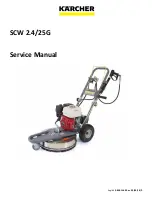
6. Maintenance
19
Read the instructions carefully. The items refer to the parts list and service kits section.
Drawing 27- 30
Gearhead & Rotor Shaft Assembly
Turn to (drawing 27): Unscrew the Gearhead Short Screws (48) from the Gearhead (13) using a 3/16" slotted screwdriver.
Remove (13) from the Gearbox (1) by pushing on its output shaft. It is not uncommon to find a slight amount of condensation
on (13).
Inspect the (13) by rotating the Rotor Shaft (21) by hand. If the (21) does not turn smoothly in both directions or feels stuck,
return the entire unit to Alfa Laval Tank Equipments, Inc. for service.
Otherwise, using a #1 Phillips screwdriver, loosen, but do not remove the Gearbox Long Screws (49). Do not disturb position of
the Gearhead Flange (53) at this time.
While holding (53) and (13) together, remove the Rotor Shaft Lower Bearing Housing (25) and (21) from (13).
WARNING: Proceed in a cautious manner when performing any work to the Planetary Gearhead due to the complexity
and size of the internal parts.
If the grease inside the (13) is completely or partially filled with liquid (cleaning fluid, water, etc.) or if the inside of the Gearhead
is dry, the grease inside the (13) may have dissolved. If this is the case, please refer to the steps below for adding grease to
the (13). If the (13) rotates freely and is adequately greased, no further inspection is required.
Turn to (drawing 30): In order to grease the gears of the (13) adequately, the Planetary Ring Gear must be removed. To do
this, hold the top tier of Planetary Gears in place with downward pressure and then pull away the Planetary Ring Gear. The
internal components (three individual tiers of planetary gears) of the (13) must remain together as a single unit. Any debris can
then be loosened and removed using an aerosol degreaser and air to dry. Once dry, the Planetary Gears can be lightly hand -
packed with grease. Alfa Laval Tank Equipment recommends using a Chevron FM NLGI 2 grease for food grade applications
and a Fuch’s ST-80 grease for aggressive chemical environments. Please consult your lubricant specialist for compatibility.
The Planetary Ring Gear can then be reinstalled by aligning the Planetary Gears with the Planetary Ring Gear on tier at a time.
Turn to (drawing 31): Inspect the Input Pinion (39) for hairline cracks on the end face or for worn, damaged, or sharp/pointed
teeth. The assembly of (39), the Rotor Shaft Carbide Thrust Washer (36) and (21) should be tight (circular scoring on the top
of the Rotor (10) and underside of Stator (9) is an indication of (39) slippage). Press (39) back onto (21) if it has slipped, or
replace if cracked.
Check for signs of scoring and wear on (21).
Check the (36) for cracks or chips, and, replace if necessary.
Turn to (drawing 29): Also, check the (60) (inside the (25)) for wear by placing the (21) back through it. There will be drag if the
(60) is still good. If it needs to be replaced, pry out the old (60), and replace it with a new one. Be sure that the seal is as
square as possible to the (25) when installing it. Apply even pressure with the use a flat-faced pin.
Inspect the Rotor Shaft Lower Bearing Housing O-ring (55) and Rotor Shaft O-ring (50) for deterioration (hardening or
deformation) or damage, replace if necessary.
Drawing 25
Output Shaft Bearing Housing
Using a 1/8" slotted screwdriver, remove the Output Shaft Seal Retaining Ring (38).
Using the same screwdriver, carefully pry the Output Shaft Upper Seal (23) out of the Output Shaft Bearing Housing (27).
Check the (23) for wear by placing back onto the Output Shaft (12) and twisting. There will be a little drag if (23) is still good.
Drawing 12- 15
Nozzle Housing
Turn to (drawing 15): Unscrew the Nozzles (7) with an open-end wrench and inspect for debris inside the (7) and Stream
Straightener (54). The inside diameter of (7) must be smooth, round, and free of damage (especially any nicks) for maximum
jet impact. Replace worn or oversized nozzles if the original flow rate is required.
Inspect the Nozzle O-rings (55) for deterioration (hardening or deformation) or damage, replace if necessary.
Turn to (drawing 13): Inspect Nozzle Housing Bevel Gear (18) for wear such as sharp/pointed or broken teeth. Also, check that
(18) does not spin relative to the Nozzle Housing (5). If the teeth are damaged or (18) can be rotated, loosen both of the Bevel
Gear Set Screws (40), and remove (18) from (5). When reinstalling the (18), ensure that the (40) are aligned with the dimples
on the (5) by removing one of the (40) and visually aligning the threaded hole in the gear with the dimple. Also, the Drive Pin
(59) should line up with the slot in the back of the (18).














































